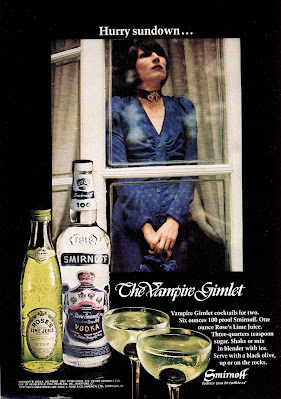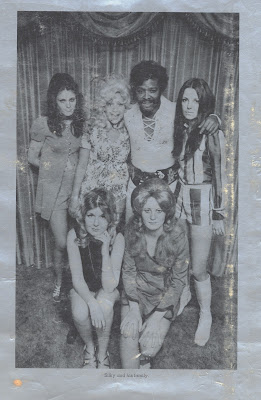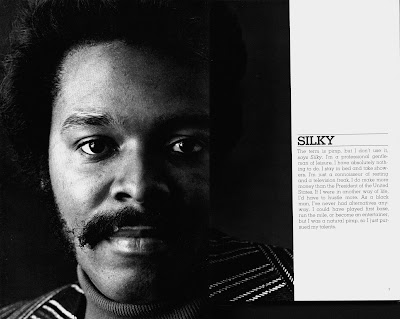Monday, February 13, 2023
Playboy magazine February 1972
Playboy magazine February 1972
Let's take a trip back in time, 51 years, in fact, to February 1972. The latest issue of Playboy magazine is on the stands.
This 232-page issue is of course thick with advertising. We have ads for liquor (I've never had a 'vampire gimlet' ?), cologne (endorsed by Joe Namath !), an automobile by Datsun, a flared suit set from Lee, and Brylcreem's 'soft hair' spray.
A pictorial features the lissome blonde Angel Tompkins, who agrees to pose in a clear, running stream (that must have been freezing cold !).
Another blonde is the February Playmate, P. J. Lansing:There are the usual cartoons:The 70s were known as the decade of self-absorption, and a feature in the February issue, titled 'Who Are We ?', certainly fits that paradigm........ a 'sensory awakening' to the accompaniment of bad, blank verse poetry.We'll close with an ad for 8 track tapes from RCA. Surely there are some worthy selections in the mix........And there you have it, magazine memories from long ago.........!
Labels:
Playboy February 1972
Saturday, February 11, 2023
Stoner books, 1979
Stoner books, 1979
'I think 'Eschatus' is pronounced 'Ess-cat-USS', that's <pffftttt> what I think'.
'I think you're sp'osed to say <pffftttt> MYTH-O-PO-EE-KONN........yeah, that's how you say it'.
Labels:
Stoner books 1979
Wednesday, February 8, 2023
Book Review: Sos the Rope
Book Review: 'Sos the Rope' by Piers Anthony
5 / 5 Stars
'Sos' is the first volume in the so-called 'Battle Circle' trilogy. The next volume in the series, 'Var the Stick', was published in 1972. My review is here. The third volume, 'Neq the Sword', was published in 1975.
The first omnibus edition of Battle Circle was published by Avon Books in 1978, and features cover art of Sos by the UK artist Patrick Woodroffe:
'Sos' is set one thousand years after World War Three (referred to as 'the Blast') has devastated civilization. Nomadic tribes, enjoying a Bronze Age level of technology, wander what was the United States. A network of technocrats, known as Crazies, maintain small settlements where nomads can, if they so desire, receive schooling, and take positions in maintaining the automated hostels that provide food, shelter, and clothing to the nomads.
The eponymous character is a sturdy young man who seeks status, and access to females, by engaging in combat in the battle circles that are scattered around the landscape. These have been established by the Crazies as a means of settling disputes through ritualized combat.
While he is dedicated to life as a nomad, Sos is considerably brighter than most of his peers, who are content to devote their earthly days to wandering, fighting, eating, copulating, and relieving themselves. Sos perceives that all is not quite what it seems, in terms of the maintenance of the post-apocalyptic society in which he is a participant.
When Sos meets a talented warrior named Sol, the two form an alliance, one that seeks to fashion the nomad tribes into a nascent 'empire'. However, the alliance is complicated by the clandestine romance between Sos and Sol's wife, an alluring woman named Sola.
When emotions come to a head, Sos find himself set upon a different path, one that will reveal to him the machinations underlying the world of the nomads and the Crazies.........and leave him as the deciding factor in whether that arrangement continues.........
By the standards of its time, 'Sos' was a five-star novel and it holds up very well today, more than 50 years after publication. The book's short length means the narrative has little room for digressions, the plot stays focused, characterizations are concise, and the portrayal of the postapocalyptic society of the battle circle provided in an economical, but adequate, manner.
It's interesting to compare 'Sos' with another of Piers Anthony's novels from 1968, 'Omnivore'. I found Omnivore to be an utter dud: turgid, self-indulgent, boring. It's hard to believe one author could produce two such different novels. My recommendation ? Skip Anthony's 'Of Man and Manta' novels, of which Omnivore is the first installment, and stick with the Battle Circle trilogy.
Labels:
Sos the Rope
Monday, February 6, 2023
More paperbacks from the UK
More Paperbacks from the UK
February 2023
February 2023
Here in Central Virginia, when a cold front moves through in the Winter, we tend to get temperatures in the mid - to - upper 30s F, and rain instead of snow. It makes for a dreary day best spent indoors, which means I have too much time on my hands to go online and order paperbacks from the UK.
I recently got a set of Corgi and Sphere Books sci-fi ('Neq the Sword', 'Death Sport', 'The Himalayan Concerto'), some suspense / crime ('Harry's Game', 'The Glory Boys', 'The Marksman', and 'Target: Amin'), and even some vintage NEL Sleaze ('The First Victorian') on this go-round.
And Spring still is a couple months away...............ahhhgggggg............
Labels:
More paperbacks from the UK
Friday, February 3, 2023
Book Review: Gentleman of Leisure: A Year in the Life of A Pimp
Celebrating Black History Month 2023
Book Review: 'Gentleman of Leisure'
by Susan Hall and Bob Adelman
New American Library, 1972
Here at the PorPor Books Blog, we celebrate Black History Month by reading and reviewing nonfiction and fiction books that illuminate the black experience. We try to focus on books that are less well-known, and have lapsed into undeserved obscurity.
Robert Melvin Adelman (1930 – 2016) was a photojournalist who was best known for documenting the civil rights movement of the 1960s. He later expanded his coverage to professional sports and urban living, publishing photoessays on those subjects.
Coauthor Susan Hall, a filmmaker and author, is alive and well. Her books include 'On and Off the Street' (1970), 'Ladies of the Night' (1973) (which also deals with the urban demimonde) and 'Down Home, Camden, Alabama' (1974).
A 2017 interview with Bob Adelman, conducted shortly before his death, is available at the Rialto Report. The interview revealed that 'Silky', the star of the book, was still alive and hustling at that time.
'Gentleman' is a photoessay that deals with the day-to-day life of Silky, and some of the girls in his stable: Sandy, Kitty, Linda, Tracey, and Lois. The book intersperses its sections of photographs with text interviews with Silky, his fellow pimps, and the girls.
We learn that Silky prefers to have white women in his stable because black women have too much drama, and are less pliable.
Silky is of course delighted to be the subject of attention and the book presents his philosophies regarding hustling, pimping, and life in general.
Playing a major role in the pursuit of The Game are its physical accoutrements: the latest and flyest clothing, and the finest of rides. A pimp who does not Represent in style is on the downward curve.
Contrary to the usual trope of pimps keeping order in their stable through the direct application of force, Silky relies on financial rewards, and displays of affection, to persuade his girls to work for him. It seems that there is no shortage of women willing to take up prostitution; indeed, Silky is constantly cycling girls into and out of his stable and bemoans the effort required to tend to so many 'employees'.
The girls are enigmatic. It's not clear how much of what they tell Susan Hall is honest and forthright, but at least superficially, they have no regrets about their choice of profession and their reliance on Silky. It's the girls that offer observations on events carefully withheld by Silky; for example, we learn from them that he was serious injured in a fight with a rival pimp, to the extent of needing plastic surgery.
'Gentlemen' closes with a Glossary, a vital source of information for anyone contemplating writing a novel or screenplay dealing with the street scene in New York City in the early 1970s:
'Gentleman' is an interesting look at an urban subculture in its heyday in the 1970s, a subculture mythologized in the novels of Iceberg Slim and referenced by modern-day rappers like Snoop Dogg. Understandably, because they wanted access to Silky and his stable, Hall and Adelman carefully avoid passing judgment on the pimping enterprise, and covering its more unsavory aspects. And no doubt, Silky and the girls presented themselves in the best possible light to Hall and Adelman. These aspects of the interaction between chroniclers and subject will of course need to be held in mind while perusing the pages of 'Gentleman'.
Copies of the book, in good condition, can be had for under $20. But if you are interested in obtaining a copy, I would act sooner, rather than later, as the price for even a marginal copy inevitably is going to rise.
Labels:
Gentleman of Leisure
Thursday, February 2, 2023
Mickey Rat
Mickey Rat
by Robert Armstrong
from Mickey Rat, No. 3 (1980)
The horror of coming home from vacation to find that, in your absence, you've had a most unwanted visitor..........
Labels:
Mickey Rat
Tuesday, January 31, 2023
Alternative Comics in 1970s New York City
'A Personal Journey Through the World of Alternative Comics in 1970s New York City'
by Michael Gonzalez
Michael Gonzalez was 13 years old when, in 1977, he bought his very first issue of Heavy Metal magazine, an action that, over the ensuing two years, inspired him to try and publish his own sci-fi comic magazine. Gonzalez touched base with many of the comic world's illuminaries in his journey (he even telephoned and talked with Leonard Mogel !).
A great reminiscence of an important era in American comics and graphic art. Even though some of the art stars Gonzalez dealt with were pricks...........!
(link to CrimeReads courtesy of the 'We Are the Mutants' Twitter feed)
Saturday, January 28, 2023
Book Review: Berserker's Planet
Book Review: 'Berserker's Planet' by Fred Saberhagen
2 / 5 Stars'Berserker's Planet' (173 pp.) is DAW Book No. 147 and was published in April, 1975. The cover illustration is by Jack Gaughan.
This is one of a substantial body of novels and short stories that made up Saberhagen's very successful 'Berserkers' franchise, which began in 1963 in If magazine with the short story 'Fortress Ship.' Additional books in the series were published well into the new century, with 'Rogue Berserker' released in 2005, just two years prior to Saberhagen's demise.
'Berserker's Planet' consists of two narratives that eventually coalesce. In one narrative, a space ship, the Orion, whose passengers are three men and three women, all of them thrill-seekers in one sense or another, makes landfall on the planet Hunter. There the male passengers are to engage in hunting the native wildlife, an exercise by which they hope to inflate their machismo, and thus enjoy the favors of the women, who are to play the role both of cheerleaders and concubines.
The space ship is piloted by the wealthy and very self-assured Oscar Schoenberg. Carlos Suomi, a business acquaintance of Schoenberg, is the one hunt participant who has misgivings about its purpose, a stance which does not elevate him in the eyes of Schoenberg.
The other narrative deals with a uniquely brutal competition being held by the priestly caste of Hunter's mountaintop Holy City, Godsmountain. Sixty-four men, originating from the various districts of the planet, have been invited to participate in a tournament involving edged weapons. The one-on-one matches are to the death, and with each succeeding round, the combat arena moves closer to the summit of Godsmountain, where, the contestants are assured, the solitary victor will sit beside Thorun, the God of the Warriors, in a kind of Hunterian version of Valhalla.
The contestants, all fighting men with what could charitably be called limited educational backgrounds, eagerly risk death in the hopes of gaining their empyrean reward. Early in the tournament, the crew of the Orion arrives at the site and its passengers are intrigued, and excited, to witness the spectacle of men slicing, dicing, and bashing each other into oblivion.
What the contestants, and the crew of the Orion, don't know is that a Berserker not only is residing on Hunter, but has plans to manipulate the parties to bring about the planet's subjugation. And after that, the galaxy awaits...........
'Berserker Planet' was not a particularly strong entry from Saberhagen, and I am comfortable with giving it a two-star Rating.
Its construction suggests that Saberhagen may have taken two independent draft novels, or novelettes, and merged them to make a sellable novel. The forced fusing of the narratives of the tournament-to-the-death contest, and the adventures of the crew of the Orion, gives the book a strained character. Although Saberhagen imbues the myriad fight scenes with due intensity (the winner never is assured), and the final chapters feature some disturbing splatterpunk imagery, as a whole, 'Berserker Planet' lacks the quality that was apparent in the franchise's entries from the 1970s.
It's true that Saberhagen was an author who wrote to earn a living, and it's unreasonable to suppose that everything he produced would be exemplary. However, 'Berserker Planet' fails to do much that is novel or imaginative with the 'killer robot' concept, and I can't recommend it to anyone other than Saberhagen enthusiasts.
Labels:
Berserker's Planet
Wednesday, January 25, 2023
The Hero by Trillo and Salinas
The Hero
by Carlos Trillo (story) and Jose Luis Salinas (art)
from Merchants of Death (Eclipse Comics) No. 1, July 1988
by Carlos Trillo (story) and Jose Luis Salinas (art)
from Merchants of Death (Eclipse Comics) No. 1, July 1988
Here's another pen-and-ink gem from the Argentinian artist Jose Luis Salinas, taken from issue one of the 40 page, magazine-sized comic book Merchants of Death, that Eclipse Comics debuted in 1988.
Other Salinas stories from this short-lived magazine that I've posted are available here and here.
Along with meticulous draftsmanship, what's also impressive about 'The Hero' is the care and attention that Salinas brings to depicting the clothing and accoutrements of the 18th century era in which this story takes place.
Labels:
The Hero by Trillo and Salinas
Subscribe to:
Posts (Atom)
















































































